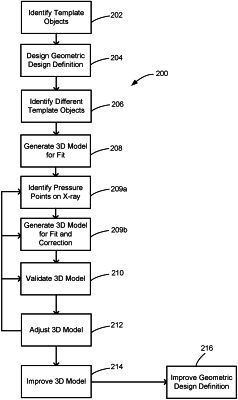| CPC A61F 2/30942 (2013.01) [G06F 30/00 (2020.01); G06T 17/00 (2013.01); G06T 17/10 (2013.01); G06T 19/20 (2013.01); A61F 2002/30943 (2013.01); G06F 2111/04 (2020.01); G06T 2210/41 (2013.01); G06T 2219/2004 (2013.01); G06T 2219/2021 (2013.01)] | 40 Claims |

|
1. A method of creating a 3D model of a device, the method comprising:
acquiring a digital representation of a first object;
determining a geometric design definition that defines a first device 3D model configured to fit the digital representation of the first object, wherein the geometric design definition comprises geometric relationships between the first device 3D model and the digital representation of the first object;
acquiring a digital representation of a second object different from the first object;
morphing the first device 3D model to fit the digital representation of the second object to generate a second device 3D model configured to fit the digital representation of the second object;
determining geometric relationships between the second device 3D model and the digital representation of the second object;
validating the second device 3D model if the geometric relationships between the second device 3D model and the digital representation of the second object are proportional to the geometric relationships between the first device 3D model and the digital representation of the first object;
creating an adjusted 3D coordinate map by adjusting a 3D coordinate map of the second device 3D model if the geometric relationships between the second device 3D model and the digital representation of the second object are not proportional to the geometric relationships between the first device 3D model and the digital representation of the first object;
morphing the second device 3D model to generate a third device 3D model using the adjusted 3D coordinate map, wherein the third device 3D model is configured to fit the digital representation of the second object better than the second device 3D model based on a fit accuracy requirement;
determining geometric relationships between the third device 3D model and the digital representation of the second object; and
validating the third device 3D model if the geometric relationships between the third device 3D model and the digital representation of the second object are proportional to the geometric relationships between the first device 3D model and the digital representation of the first object.
|